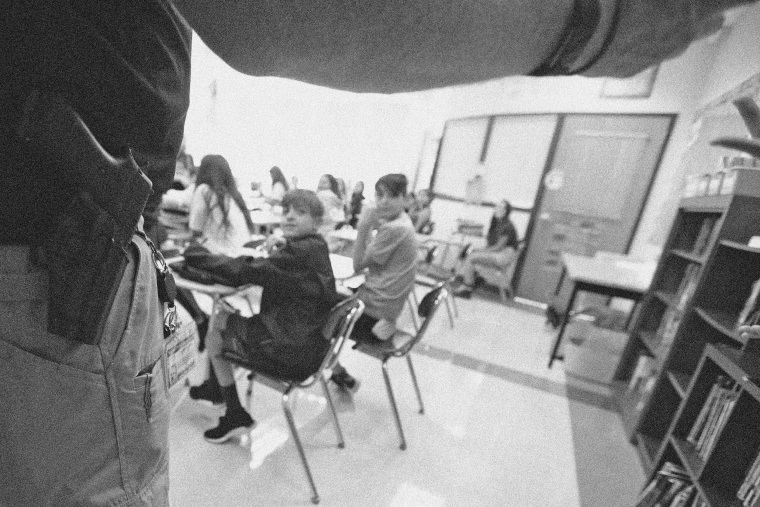Congressional Democrats will introduce a bill to make it illegal for any school receiving federal funding to use seclusion or dangerous restraints on students.
The Keeping All Students Safe Act would bar school personnel and police stationed on campus from physically restraining students in potentially life-threatening ways, like restricting their breathing or using a prone or supine restraint. Non-life-threatening restraint tactics — except prone or supine — may be used if the student "poses an imminent danger" to themselves or those present.
Sens. Chris Murphy, D-Conn., and Patty Murray, D-Wash., will reintroduce the bill Wednesday with the support of more than two dozen organizations including the National Autism Association, the Alliance Against Seclusion and Restraint and the Center for Learner Equity (formerly the National Center for Special Education in Charter Schools). Murphy is also one of the lawmakers behind the Counseling Not Criminalization in Schools Act, which would create a billion-dollar grant program to divert funding from school policing to community programs.
“The data tells us that seclusion and restraint practices in school are dangerous, ineffective and predominately used against kids of color and students with disabilities,” Murphy said in a statement. "These practices leave traumatic, and sometimes fatal, fingerprints on those affected, and we need to stop them."
Versions of the bill have been introduced since 2009 as experts said seclusion and forceful restraints could traumatize children and lead to injuries or death.
The reintroduced law would provide "developmentally appropriate" training and require states to monitor the law's implementation. School personnel and police would have to undergo state-approved crisis intervention training administered by the Department of Education.
"Despite evidence that seclusion and restraint practices make schools less safe, thousands of students are still subjected to these dangerous discipline methods," said Rep. Robert C. “Bobby” Scott, D-Va., chairman of the House Committee on Education and Labor. "Students of color and students with disabilities are disproportionately impacted by these harmful practices. A quality education cannot be achieved without a safe learning environment."
Advocates like Lisa Thurau, founder of Strategies for Youth, which trains police officers to interact with children and tracks use-of-force lawsuits, have worked for years to urge lawmakers to prioritize such training.
"I've learned how little officers are equipped to work with teenagers, much less kids. I've been training officers, and an officer's willingness to look for a different approach is dramatic in most places," Thurau said in a previous interview. "But what we don't see is law enforcement leaders considering changes in policy. The federal government should enact legislation. Training is necessary but not sufficient. I can't bear to think we're not doing our best to protect kids."
Advocates of police-free schools say the bill is a first step in a long journey.
"It's an excellent start, but it's just a start," said P. Angelicia Simmons, executive director of the Fannie Lou Hamer Institute of Advocacy and Social Action. "My only question is how they'd determine whether a child is being a danger to themselves. I think that's ambiguous. But this will open the door for conversation and have us rethinking how our schools and our children should be protected."
Seclusion and restraint practices are commonly used in schools, most often on boys and kids with disabilities, according to the U.S. Government Accountability Office. Some 101,990 students total were secluded or subdued with a physical or mechanical restraint during the 2017-2018 school year, the CRDC found.
There are no federal laws governing how seclusion and restraints can be used in schools, and there are no sweeping federal laws with specific guidelines for police use of force on children in general. Advocates and organizers working to have police fully removed from schools note that many interactions between Black children and police occur in schools, and those with larger Black and Latino populations are more likely to have police officers in the halls, metal detectors and security cameras. Thus, organizers have demanded for years that federal officials stop pouring millions of dollars into school policing programs.
"I believe that in order to really stop the harms of police, we have to remove them from schools," said Erika Strauss Chavarria, an organizer of Black Lives Matter at School. "I do agree with training all school staff in de-escalation tactics, relationships with the students, how to engage with students that may be in crisis."
"I'm glad that there is at least a conversation about the role of police in schools," Strauss-Chavarria said. "It should be that any school receiving federal funding should be police-free. There should always be funding a resources for training staff in restorative justice practices, in de-escalation, in relationship-building, all of those things. I'm glad it makes something illegal for police, but it's not enough."
Follow NBCBLK on Facebook, Twitter and Instagram.
CORRECTION (May 27, 2021, 11 a.m. ET): A previous version of this article misstated which agencies would provide training for school resource officers in the bill. It would be provided by each state's department of education, not the U.S. Department of Education.


